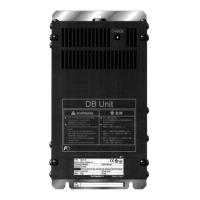7.2 Daily Inspection
7-2
7.2 Daily Inspection
Visually inspect the inverter for operation errors from the outside without removing the covers when the inverter is
running or the power is ON.
Table 7.2-1 lists daily inspection items.
Table 7.2-1 Daily Inspection List
Check part Check item How to inspect Evaluation criteria
Environment 1) Check the surrounding
temperature, humidity, vibration
and atmosphere (dust, gas, oil mist,
or water drops).
2) Check that tools or other foreign
materials or dangerous objects are
not left around the equipment.
1) Check visually or
measure using
apparatus.
2) Visual inspection
1) The usage environment
given in Chapter 1,
Section 1.3.1 must be
satisfied.
2) No foreign or dangerous
objects are left.
External
appearance
and others
1) Check that the bolts securing the
wires to the main circuit terminals
and control circuit terminals are not
loose before turning the power ON.
2) Check for traces of overheat,
discoloration and other defects.
3) Check for abnormal noise, odor, or
excessive vibration.
1) Retighten before
turning the power
ON.
2) Visual inspection
3) Auditory, visual, and
olfactory inspection
1) No loose screws. If
loose, retighten the
screws.
2), 3)
No abnormalities
Cooling fans Check for abnormal noise or
excessive vibration when the cooling
fans are in operation.
Auditory and visual
inspections
No abnormalities
Keypad Check for alarm indication. Visual inspection If any alarm is displayed,
refer to Chapter 6.
Performance Check that the inverter provides the
expected performance (as defined in
the standard specifications).
Check the monitor
items shown on the
keypad.
No abnormalities in the
output speed, current and
voltage and other running
data.

